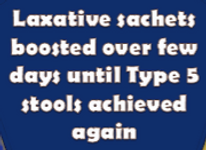
Maintenance Regime
Once dis-impaction is complete, the amount of laxatives' required will decrease, albeit very slowly The maintenance dose will be different for every child and put simply, it is:
The amount of sachets it takes to ensure your child passes a Type 5 poo everyday, with no issues.
Too many sachets will likely result in loose stools, and too little will regress back into constipation. The maintenance regime is about recognising the right amount of sachets for your child. So, if your child needs 4 x sachets daily in order to produce a type 5 poo, then that will be their maintenance dose, required to be taken every single day.
If you child has suffered with constipation for a considerable amount of time, their rectum is likely to have become stretched. This will take time to recover, therefore your child will most likely need to take laxatives for a long time. Your child needs to be passing Type 5 stools for a minimum of 6 months in order to decrease their maintenance dose of laxatives.
Once your child has successfully been passing Type 5 stools every day, for 6 months with no issues, it may be possible to titrate the sachets down. It is suggested that you could start to reduce the laxative sachets by half to one at a time. For example, if your child's maintenance dose is 2x sachets daily, you could reduce down to 1-1.5x sachets each day, to one or one and a half. Stay at that reduced dose for a minimum of four to six weeks before trying to reduce sachets any further.
Stimulant medication should also be reduced slowly. These should be reduced by about 2.5mls at a time. For example, if your child takes 10mls stimulant every day, then you could begin by reducing to 7.5mls a day and would then stay at that dose for at least four to six weeks, before attempting to reduce again.

What We Are Aiming For...
We always recommend using the Bristol Stool Chart as your reference to your child's poo.. It can be found at the bottom of this website, along with a copy available for download or printing found on our "Information Leaflets" section. It is a good tool to use when describing your child's poo, along with keeping track of just what stools they are passing.
Stool Types 1, 2 and 3 are harder, drier and usually really large poos. So, that means that these poos need more water, to make them soft and easy to pass. So, in other words, they need an increase in the macrogol dose.
If your child is doing a Type 6 or 7 poo, it now has too much water in it. So the macrogol dose needs to decrease in order for the poo to my more formed and the child to have more control.
Many parents tell us that when they started taking to macrogol, the poo became very runny and they thought their child had diarrhoea, so they stopped giving it. Please do not stop the macrogol. Remember that this adds water to the poo, so this runny poo is not diarrhoea - it is just poo with macrogol in it. So if it becomes too runny, just reduce the dose. If it is getting a bit harder again or your child does not pass their daily poo, then increase. Aim for your child to be passing a poo everyday.
Play around with your child's macrogol dose.
If in doubt, always give more macrogol than less.
DO NOT BE AFRAID OF INCREASING MACROGOL - IT IS ONLY ADDING WATER TO YOUR CHILD'S POO !










Disimpaction & Maintenance at a Glance



.png)


